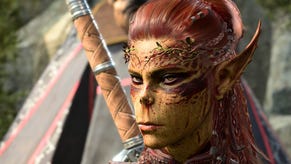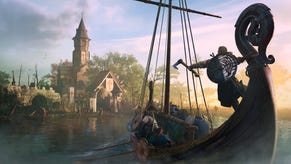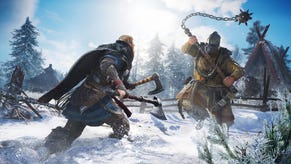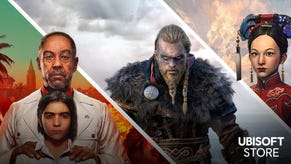Seven hours with Assassin's Creed Valhalla
Viking direct.
Amongst scattering foxes and swaying foxgloves, on bracken-covered hills squared off by broken drystone walls, the Ancient Britain of Assassin's Creed Valhalla is a beautiful sight. Its palette is muted compared to the sunnier climes of Odyssey - here, a ruddy, muddy mix of reds and browns, often dimly lit under England's smurring clouds. For six hours I get to explore this world - specifically, Ledecestrescire - Valhalla's second British region after opening in East Anglia.
Main character Eivor is still new to the country, her settlement only just founded, and nowhere near as developed as Eurogamer's in-depth tour of its evolution revealed earlier this week. The Vikings are still early on in their British conquests - and likewise, this Ledecestrescire chapter feels very much like Valhalla's early game. Eivor has few showy special powers, and must engage in a relatively linear arc to establish her people's foothold by deposing a local ruler and installing a puppet replacement friendlier to their cause.
We begin in Ravensthorpe, Eivor's new home, as most of Valhalla's other main missions will begin also. One small detail here I couldn't share earlier this week - Ravensthorpe will be your portal not only to other English locations, but those much further afield. By communing with your seer you can explore multiple "mythworlds" involving the Norse gods, such as Asgard and Jotunheim. Ravensthorpe will also be your staging ground for a journey to North America - though the suggestion was this will be another small realm for you to visit.
Back to the action at hand, as Eivor is directed to Ledecestrescire and to her brother Sigurd, who is working with keen raiders Ivarr and Ubba Ragnarsson. Together the four of them must get rid of current Mercian king Burgred and swap him for Ceowulf, another Saxon who they can control. This story plays out over a single arc, though there's freedom to wander all over the region and take in the various campaign moments at your own pace. There are, of course, numerous distractions and other activities to tempt you off the beaten track, all of which have now been made more mysterious by appearing only as glowing dots on your map until investigated more thoroughly.
Sticking to the campaign for now, Eivor meets with the brothers Ragnarsson. Together, they make a plan to split up and go after the fleeing King Burgred and his wife, both of whom have gone into hiding. You'll work with the stoic Ivarr for one of these missions, and the hotheaded Ubba for the other. Ubba is the kind of typical "wacky" mission sidekick who initially grates a little - you first meet him in the midst of torturing a poor local he has dangling from the ceiling in a scene which Ubisoft tries to play for laughs - though a later moment where he and Eivor share a quiet drink and talk more about their backgrounds makes him slightly more palatable.
The mission to locate King Burgred's wife sees Eivor infiltrate a castle and practice some of her (still rather rusty) Assassin skills. There are multiple opportunities to pick off guards dotted around the battlements, highlightable using Eivor's Eagle Vision-like Odin Sense ability, while trusty raven Sýnin can scout from the air. It's difficult to judge Valhalla's suite of abilities from this early look, though it was admittedly jarring after being used to my fully-powered up demigod Kassandra, compared to the very much human Eivor here with few points installed in her own skill tree. Notably, there didn't yet seem to be a way for Sýnin to mark enemies from above as your eagles could in Origins and Odyssey. But who knows, down the line?
Valhalla has an enormous web of upgradable skills and stat upgrades which sit in your character menu. Laid out like constellations in a planetarium, the vast majority of its nodes remain covered by fog until you progress further down each branch. I could see early options to unlock different assassination methods, buff health, and begin adding special abilities. You can unlock the ability to counter damage and roll after falling, for example (Odyssey's immunity to fall damage is very much no longer present, Eivor discovered the hard way). For now, though, combat remained an enjoyable challenge, with its addition of a second held item (be it a shield, or dual-wielding two axes) used to block certain hits. Fans of FromSoftware fare will recognise Valhalla's telegraphing of attacks you can parry (which flash up in amber) and those you must use Odyssey's returning dodge roll to entirely evade (which flash up in red).
The addition of a shield (or two shields, if you fancy dual-wielding those) feels like a direct response to Odyssey's lack of them - something criticised by fans since shields were used by Kassandra's enemies and were, let's be honest, quite an iconic part of the Ancient Greek look. There are other changes from Odyssey to Valhalla that also feel a clear reply to fan critique - such as the scaling back of the former's XP and levelling system, which came under fire for gating player progress while XP boosts sat within the in-game shop. Valhalla now has Destiny-like power numbers on individual gear items which increase Eivor's overall strength, while her stat upgrades sit on the aforementioned constellation skill tree, with nodes unlocked by completing activities.
With King Burgred's wife found, it was onto the man himself. Evidence pointed to him hiding within a church in Repton, an area Eivor must skulk about unseen, her hood up. It's been a while since Assassin's Creed included large map areas where its main character was continually at risk - but then again, it's been a while since you could blend in with NPCs by hiding between them or sitting down on a nearby bench. I distracted one enemy by directing a mumbling drunkard into their path, then slipped into the church itself. Inside, instead of Burgred, Eivor found another clue to his whereabouts - and also Ceolbert, the fresh-faced son of Ceowulf, the puppet king Eivor was hoping to install.
Over the course of these missions I enjoyed the character of Ceolbert - a young, rather meek boy unused to war - trying to find his feet amongst the Vikings' constant slaughter. Valhalla is often pretty bloody - in a way Assassin's Creed hasn't really been before. Heads are regularly lopped off in combat and roll around the floor. Prone enemies can be brutally stomped on. Later assassination abilities give a Mortal Kombat X-Ray view of your Hidden Blade sliding into people's skulls. Ceolbert's path through all this, and the moments Eivor looks out for him, in turn offer a little more to her character.
The end of this story arc sees you finally forcing Burgred to hand over his crown, installing Ceowulf as your puppet ruler in the process. I got the sense this final scene could have played out a couple of ways, though in isolation it's difficult to say how much the few dialogue choices I got over the course of the arc really affected how things played out. Rather than an expansion of Odyssey's branching narrative choices, Valhalla feels - in this sequence, at least - to have pared things back. The dialogue options I saw were all similar-feeling responses, with no further follow-ups or lines of questioning.
There seemed to be less time spent standing around talking overall, with dialogue given simply during normal gameplay, or Red Dead Redemption-style while travelling to a destination on horseback. But, again, how representative this will be of the overall game remains to be seen. One element from Odyssey I was pleased to see remain is its more light-hearted and bawdy tone, compared to the straight-faced Origins. Rest assured, Valhalla does not let the opportunity for an Ivarr the Boneless gag slide.
With Ledecestrescire's story arc completed, it was time to explore a little more of its open world. In another nod to Red Dead Redemption, many of the side-stories I found here consisted of short vignettes with odd strangers found in specific places, and each were wrapped up within minutes. I ventured into a burning building to help find a couple of brothers' lost treasure, only for them to realise they had the treasure all along. I helped a group of armed nuns escape into the next county. I consoled a young girl whose father had left for battle and not returned. I ate a mushroom I found on a mountainside and followed a psychedelic hallucination of a seal to complete a simple puzzle. I hunted snakes to give a strange woman their eggs, for seemingly no reason other than a fart joke.
Ubisoft has spoken previously of changing how side-quests work for Valhalla, and that these "world events" make more sense for Eivor as a passerby than longer questlines might do for a local. After playing these, all I can say is it is disappointing how thin these feel compared to the more involved Witcher-esque stories Odyssey had to offer, with little to no decisions to make which affect their outcome. It remains to be seen whether any of these characters return, or if the missions involving characters in your settlement end up filling the gap.
Six hours later, I feel like I've seen a lot of what Valhalla may have to offer, but am still cautious about making further assumptions with so little of its world and web of characters uncovered. I'm impressed by Britain's design, quite enamoured with Eivor, and keen to see how her story develops. I'm hopeful for snazzier Viking and Assassin powers down the line. I'm less hopeful about the apparent lack of choice in its narrative and trivial side quests. There's just a month to go until the Valhalla's full saga begins for real.















